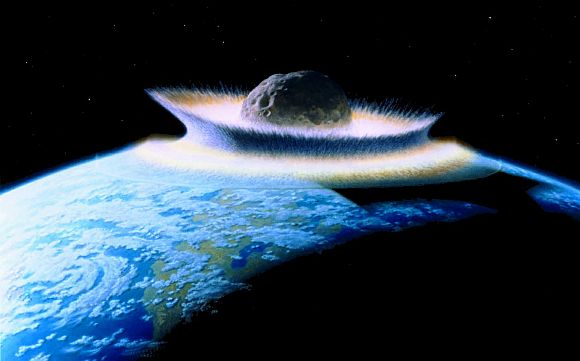 | « Back to article | Print this article |
India among 10 nations on doomsday asteroid target
India, China and the United States are among the 10 countries that are most at risk of being obliterated by an asteroid.
Observations from NASA's Wide-field Infrared Survey Explorer have led to the best assessment yet of our solar system's population of potentially hazardous asteroids. The results reveal new information about their total numbers, origins and the possible dangers they may pose.
Potentially hazardous asteroids, or PHAs, are a subset of the larger group of near-Earth asteroids. The PHAs have the closest orbits to Earth's, coming within five million miles (about eight million kilometers), and they are big enough to survive passing through Earth's atmosphere and cause damage on a regional, or greater, scale.
The new results come from the asteroid-hunting portion of the WISE mission, called NEOWISE. The project sampled 107 PHAs to make predictions about the entire population as a whole. Findings indicate there are roughly 4,700 PHAs, plus or minus 1,500, with diameters larger than 330 feet (about 100 meters). So far, an estimated 20 to 30 percent of these objects have been found.
Click on NEXT to read further....
India among 10 nations on doomsday asteroid target
The new analysis also suggests that about twice as many PHAs as previously thought are likely to reside in "lower-inclination" orbits, which are more aligned with the plane of Earth's orbit. In addition, these lower-inclination objects appear to be somewhat brighter and smaller than the other near-Earth asteroids that spend more time far away from Earth.
A possible explanation is that many of the PHAs may have originated from a collision between two asteroids in the main belt lying between Mars and Jupiter. A larger body with a low-inclination orbit may have broken up in the main belt, causing some of the fragments to drift into orbits closer to Earth and eventually become PHAs.
Asteroids with lower-inclination orbits would be more likely to encounter Earth and would be easier to reach. The results therefore suggest more near-Earth objects might be available for future robotic or human missions.
The WISE spacecraft scanned the sky twice in infrared light before entering hibernation mode in early 2011. It catalogued hundreds of millions of objects, including super-luminous galaxies, stellar nurseries and closer-to-home asteroids.
Click on NEXT to read further...
India among 10 nations on doomsday asteroid target
Quoting Nick Bailey of the University of Southampton's School of Engineering Sciences team, the DailyGalaxy.com website reported, "The threat of the Earth being hit by an asteroid is increasingly being accepted as the single greatest natural disaster hazard faced by humanity."
In 2009, Bailey and his colleagues used raw data from multiple impact simulations to rank each country based on the number of times and how severely they would be affected by each impact. The software, called NEOimpactor (from NASA's "NEO" or Near Earth Object programme), was developed for measuring the impact of 'small' asteroids under one kilometer in diameter.
Results indicated that in terms of population lost, China, Indonesia, India, Japan and the United States face the greatest overall threat; while the United States, China, Sweden, Canada and Japan face the most severe economic effects due to the infrastructure destroyed.
"The consequences for human populations and infrastructure as a result of an impact are enormous," Bailey said, adding, "Nearly one hundred years ago a remote region near the Tunguska River witnessed the largest asteroid impact event in living memory when a relatively small object (approximately 50 metres in diameter) exploded in mid-air. While it only flattened unpopulated forest, had it exploded over London it could have devastated everything within the M25. Our results highlight those countries that face the greatest risk from this most global of natural hazards and thus indicate which nations need to be involved in mitigating the threat."
Click on NEXT to read further...
India among 10 nations on doomsday asteroid target
"The NEOWISE analysis shows us we've made a good start at finding those objects that truly represent an impact hazard to Earth," said Lindley Johnson, programme executive for the Near-Earth Object Observation Programme at NASA Headquarters in Washington.
"But we've many more to find, and it will take a concerted effort during the next couple of decades to find all of them that could do serious damage or be a mission destination in the future."
The NEOWISE project snapped images of about 600 near-Earth asteroids, about 135 of which were new discoveries.
Because the telescope detected the infrared light, or heat, of asteroids, it was able to pick up both light and dark objects, resulting in a more representative look at the entire population. The infrared data allowed astronomers to make good measurements of the asteroids' diameters and, when combined with visible light observations, how much sunlight they reflect.
Click on NEXT to go further....
Top photo features of the week
Click on MORE to see another set of PHOTO features...




